THE DATINI's ARCHIVE: the Ledgers

The approximately 600 codes dedicated to accountacy which were kept on the eight Datini premises are of a merchant-banking nature or else specialised in banking and industrial accountancy.
Their number varies according to the size of the company and the traffic channels that it had. We find ledgers common to all the companies in each series, so that they can be classified in definitive records or ones subjected to synthesis and preparatory or analytical entries.
Their number varies according to the size of the company and the traffic channels that it had. We find ledgers common to all the companies in each series, so that they can be classified in definitive records or ones subjected to synthesis and preparatory or analytical entries.

Definitive records or ones subjected to synthesis
- Book of debtors and creditors (or Large Book)
- Trade ledger (which may also be found in a section of the Book of debtors and creditors
- Debit and credit ledger

Preparatory or analytical entries
- Historical record
- Cash book
- Book of merchandise expenditure
- Book of received and mandate di balla (forwarded bales)
- Household expenses ledger
- Quaderno delle ricordanze (Book of pledges)

These registers are flanked by books of various nature which were opened according to the particular needs of the company. These are:
- Postal book: the register where all in-going and out-going post was recorded
- Libro di suggello (Book of Seals): this kept a record of the income and outlay of moneys made in suggello (sealed) florins, these are florins contained in a sealed bag to secure the coinage and its weight.
- Libro del chiesto (Book of requests): intended for fixing all "orders" for the supply of goods.
- Quaderno di lane (Book of wools): kept by administrators in the wool-producing centres for the recording of all wool stocks.
- Libro di possessioni (Book of belongings): contains all the real estate.
- Libro dei ma' debitori (Book of bad debtors): it was used when an accounting period was closed, collecting together all credits held to be uncollectable.
- Staff book, for companies of the Arte della Lana (Wool Guild): it served to keep a note of staff presences (not the "absences", for which there was a special book known as degli scioperi).
- Quaderno di sicurtà (Book of insurance): collected all details of insurance contracts with the company acting as insurer.
- Book of ship's cargo and valute di mercanzia the rates of merchandise): all ships' cargoes and the rates of received goods and those to be forwarded were copied out in it.
- Book of exchange: contains the complete record of bills of exchange.
- Libro segreto (Secret book): that is the register with the business name, the patti di compagnia (company contracts) and the individual stock and profit accounts; and various Quaderni dei ragionamenti (Books of Negotiations) the analytic contents of which were entered in Libro segreto (Secret book).

According to the specialisation of the company, such as those della Lana (of Wool) and della Tinta (of Dyeing), special books were opened concerning the various stages of the workings of the wool and of the resultant cloth, such as the ones called Lavoranti e lanaioli (Workers and Woollen Drapers), Filatori (Spinners), Tessitori e tessitrici (Weavers), Tintori e conciatori (Dyers and Tanners), "Vagelli" (Dye tanks), etc.